You might think that Bolognese sauce is off-limits if you stick to a low FODMAP diet (or cook for someone that does). Not the case. My Low FODMAP Bolognese sauce isn’t even a compromise. With a couple of tweaks, even low-fodmappers can enjoy this classic family favourite.
My recipe is a perfect balance of umami and sweet, tomato and meat, with complex notes added by (not so!) secret ingredients. My family love it, I’ve now got a Bolognese sauce recipe I’m proud of (after a lot of trial and error) and I’m happy to share it!

🥘 Ingredients

Ingredients (from top clockwise)
- canned tomatoes with passata, bay leaves & paprika
- pureed anchovies & chicken livers
- milk & white wine
- pork & beef mince (ground)
- bacon
- carrot
- parsley
- celery
- sage
What makes this recipe low FODMAP?
There’s no onion or garlic. I'm told that garlic is not traditional in a Bolognese anyway! 🤨. I’ve made sure that ingredients with FODMAPs (celery and tomatoes) are within recommended limits. I’ve made specific notes about these limits in the recipe. My suggested portion size of Low FODMAP Bolognese is 200g per person. This is generously-sized, don’t you worry! You would use lactose-free milk and serve the sauce with a gluten-free pasta. I use the guidelines set out by the Monash University FODMAP diet. Their app is really useful. It's convenient and easy to use, even when you're on the go - in the supermarket or out for dinner.
Wait. Anchovies and chicken livers?
Busted. These are the ‘umami bombs’. I love anchovies actually and whilst I won’t pretend I eat a lot of liver, I do love chicken liver pate (recipe coming!). Bear with me here though. We’ve all had bad Bolognese sauce – the type they have on kid’s menus 😩. They taste like mince in tomato ketchup. Super sweet and one-dimensional. Good Bolognese sauce needs to taste savoury. Even with the sweetness of tomatoes and the milk in some recipes, including this one. Some recipes suggest adding a little fish sauce, quick to assure that ‘you won’t be able to taste it’. I tried it – only two tablespoons’ worth for this recipe. I could taste the fish sauce and found it weird. I like the combination of a tiny amount of anchovy (you really can’t taste them) and pureed chicken livers. This combo doesn’t look appealing in its initial state. It makes a big difference in the final flavour and is worth including. I also throw in a parmesan cheese rind if I happen to have one. I keep a stash of these in the freezer. Parmesan, liver and anchovies add umami (savoury) flavour to keep this Bolognese balanced.
Why do carrots and celery take so long to soften?
The hardest thing about this recipe is dicing the carrot and celery nice and small. The second hardest thing is being patient enough to soften them over low heat. Most recipes underestimate the time it takes to do this. This is a step we need to do before adding the meat and other ingredients. Don't make the mistake of thinking they'll soften in the sauce. It's surprising how much bite they can keep if not softened enough in the beginning. The addition of salt seasons the vegetables but also encourages them to soften. Despite any temptation you may have to speed things along, keep the heat low until the last few minutes. We don’t want the veg to brown and crisp, just soften. If you pick up a piece of carrot or celery, you should be able to smoosh it between your fingers. The finished Bolognese sauce needs to be soft with no crunchy bits getting in the way.
Fat is flavour – no lean mince please!
I recommend using mince with at least 10% fat for better flavour and texture. You won't see me suggesting lean mince ever actually!
😂 And no, I don’t drain the fat from the pan after browning the mince. That’s not ‘just’ fat, it’s flavour too.
Milk & Wine? Together?
We add milk and wine (white or red) and cook over high heat to drive off the water they contain. They leave a residual sweetness and richness that tenderises the meat. It’s a wonderful technique common in Northern Italy. If you measure them out together in the same measuring jug and leave to sit for a while, the mix may curdle. This is fine to go ahead and use – the acid in the wine reacts with the milk. It won’t affect the finished dish.
Passata & canned tomatoes
Canned tomatoes = peeled whole tomatoes ie no skin, but have seeds. They’re already cooked (they cook in the can during the sterilisation process).
Passata = peeled tomatoes, but the tomatoes are uncooked. They have been pulverised and sieved to remove the seeds. This creates a smooth, thickened sauce. Passata comes in a glass jar instead of a metal can to avoid the metal tainting the fresh tomato flavour.
In short, passata and crushed whole canned tomatoes are pretty similar.
I recommend using a combination of canned tomatoes and passata for this recipe. Hand-crushed whole canned tomatoes add a bit of texture, and passata is thick and smooth and sweet. It's not a deal-breaker if you mix and match in different ratios depending on what size jar/cans you can find. It’s pretty annoying to use half a can of tomatoes or part of a jar of passata. The most important thing is not to exceed a total volume of 1200g of tomato if a low FODMAP diet is important to you. This is assuming a 200g portion size.
👪 Serving size
Batch cooking
This makes a lot of sauce. Enough for two large lasagne (6 servings each) or 12 portions of Bolognese sauce for pasta. It freezes so well; it makes sense to make a large batch and freeze leftovers for another meal or two.
🔪 Instructions
Overview of recipe steps
- sauté finely chopped bacon
- add finely chopped celery, carrots and fresh herbs. Allow some time for them to soften over gentle heat. Set aside
- brown mince - beef or a combination of beef and pork
- add umami ‘flavour bombs’ and then the bacon/veg back to pan
- add milk and wine and reduce to concentrate flavour
- add tomatoes and simmer over low heat for around 90 minutes, stirring occasionally
- Starting in a cold pan, we cook finely chopped bacon

2. Add finely chopped celery, carrots and fresh herbs. Allow some time for them to soften over gentle heat. Set aside.

3. We brown mince - beef, or a combination of beef and pork. We add umami ingredients (chicken liver & anchovies). We return the veg and bacon to the pan.

4. We add milk and wine (white wine was used in the photo below) and reduce to concentrate flavour.

5. We add tomatoes - whole canned & sieved. We simmer over low heat for around 90 minutes, stirring occasionally until rich and tender.

Remember to look after your sauce
What if you forget to stir every 15 minutes or so and the sauce starts to stick at the bottom of the pan? Whatever you do, don’t be tempted to scrape the bottom of the pan! Stir around it so that you don’t impart any burnt residue into all the rest of the sauce. Maybe set 15-minute timers next time (can you tell I do this?)
❓FAQ
I allow 200g per person. This is a generous amount of sauce. This is not the traditional Italian way….but it seems to be the way the rest of the world enjoys it 😂
Apart from ‘Spag Bol’?! Layered in Lasagne, inside arancini. On baked potatoes. With rice. Babies love it as is! If you are serving with pasta, remember to stir some sauce through the drained pasta too. The rest of the sauce can sit on top of the pasta. Nude pasta is bland – both visually and in taste. Plus it can stick together, which is so horrible.
I recommend weighing 200g portions (or multiples of) straight into ziplock bags. Push any air out, seal up well and flatten the sauce into a thin layer. Stack in the freezer (don’t forget to label!). These layers of sauce are a breeze to defrost fast (and take up less space in the freezer). What if you forgot to take it out of the freezer? Break into shards, tip the bits into a saucepan. Defrost/reheat over gentle heat while the pasta is cooking.
Whilst I often add sugar to my tomato-based sauces to counteract the acidity, this Low FODMAP Bolognese sauce doesn’t need any because of the natural sweetness of the milk.
Yes! It’s rich and thick enough to use in Lasagne. This recipe makes enough sauce for two large lasagnes that would feed six people each.
📖 Recipe
Equipment
- Large casserole pot with a lid
- Stick blender or small food processor
Ingredients
* notes for low FODMAPPERS
- 100 g smoked streaky bacon about 4 rashers
- 2 celery stalks *no more than 120g prepared weight in total
- 2 carrots
- large handful parsley leaves about 10g
- small handful sage leaves about 5g
- large knob butter about 20g
- olive oil
- 1 teaspoon salt
- freshly ground black pepper
- 80 g chicken liver (note)
- 6 anchovy fillets about 10g
- 1 kg beef mince (or beef and pork) not lean
- 350 ml whole milk (*lactose-free)
- 250 ml wine white or red
- 400 g canned whole tomatoes
- 700 ml passata
- ¼ teaspoon hot smoked paprika
- 2 bay leaves
- parmesan rind (optional)
Instructions
- Bacon, Celery, Carrot, Parsley & Sage – finely chop the bacon and set aside. Finely chop the celery, carrot, parsley and sage.100 g smoked streaky bacon2 celery stalks *no more than 120g prepared weight in total2 carrotslarge handful parsley leavessmall handful sage leaves
- Sauté Bacon – in the (cold, unoiled) pot, add the bacon. Place over low heat and cook, stirring often, until the bacon fat starts to melt. The bacon will start to brown and crisp a little.
- Sauté Veg – add the butter and two tablespoons of oil to the pot. When the butter has melted, add the celery, carrot, parsley and sage. Add the salt and plenty of freshly ground black pepper and stir well. Put the lid on and cook, stirring often for around 10 minutes. We want the veg to soften (not brown). You should be able to squash pieces easily between your finger and thumb.large knob butterolive oil1 teaspoon saltfreshly ground black pepper
- Chicken Livers & Anchovies - while the veg is cooking, blend the chicken livers and anchovies together. You can use a stick blender or small food processor. Transfer to a small bowl. Make sure you use a deep container if you’re using a stick blender!80 g chicken liver6 anchovy fillets
- Remove Veg – once the vegetables are very soft, transfer them to a small bowl. Keep the lid off the pot now for the rest of the cooking time.
- Brown Meat - turn the heat under the casserole pot to max. Add two tablespoons of oil and then all the mince, breaking up large chunks with a flat-ended wooden spatula. You’re not aiming to crisp up the meat here, just brown. This will only take a few minutes.olive oil1 kg beef mince (or beef and pork)
- Cook Liver & Anchovies – add to the meat and cook for a couple of minutes, stirring often. It will turn from a dull red to a brown that blends in.
- Return Veg - add the veg back to the pot and mix through. Cook over high heat for a few minutes, stirring often until most of the water in the pan has gone.
- Milk & Wine – add the milk and wine to the pot and stir through. Keeping on high heat, cook until most of the liquid evaporates, stirring occasionally. This will take around 15 minutes.350 ml whole milk (*lactose-free)250 ml wine
- Crush Tomatoes – meanwhile, tip the can of tomatoes into a large bowl & squeeze by hand. Do this slowly, one at a time under the surface of the tomato juice. Keep the can.400 g canned whole tomatoes
- Tomatoes, Paprika, Bay Leaves & Parmesan Rind - add the crushed tomatoes and all the passata to the pot. Measure out 300ml water and use this to rinse out the can and passata bottle, adding all the tomatoey liquid to the pot. Add the paprika, bay leaves and parmesan rind (if using). Stir everything together.700 ml passata¼ teaspoon hot smoked paprika2 bay leavesparmesan rind
- Slow Cook – maintain a gentle simmer for around 1 ½ hours, until the sauce is thick, and the meat is tender. Stir more frequently towards the end to ensure the sauce doesn’t burn at the bottom as it thickens.

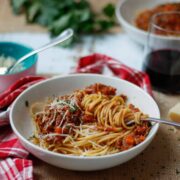
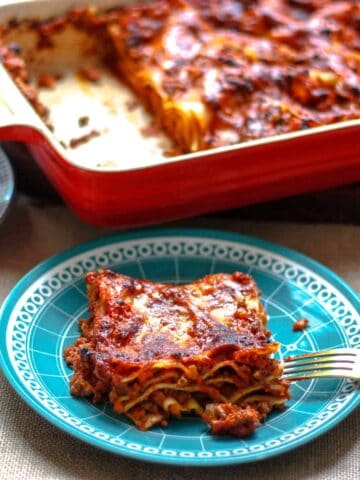
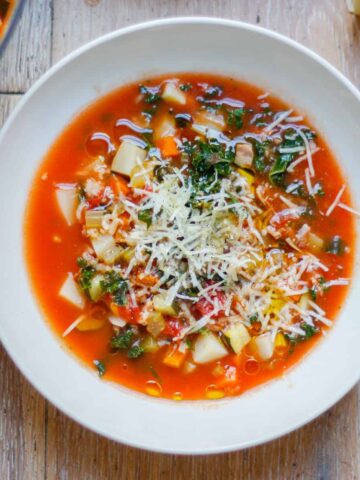
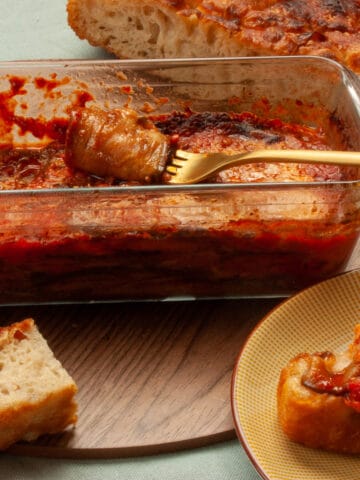

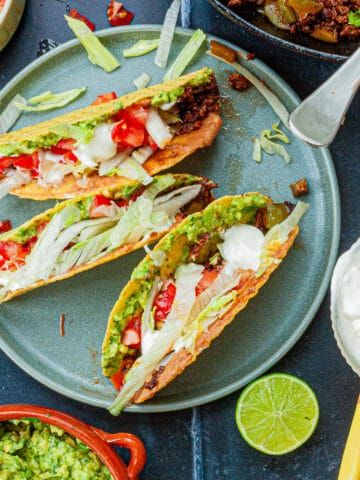
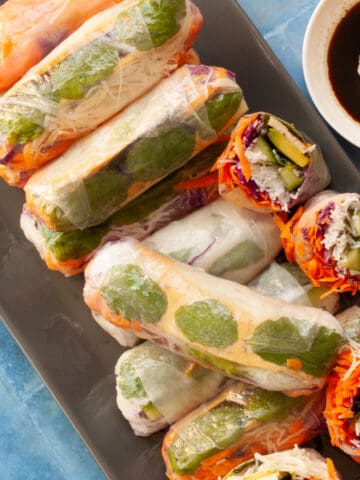

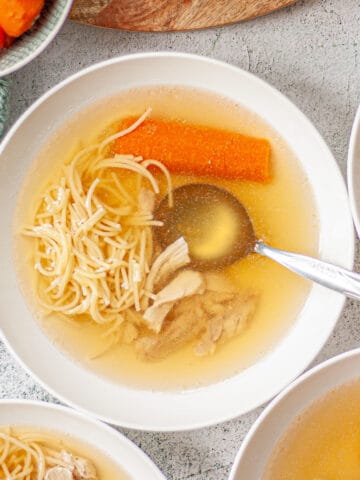
Comments